by Winding Pathways | May 5, 2022 | (Sub)Urban Homesteading, Birds, Nature
When recently walking for exercise at a cemetery our ears and then eyes alerted us to an amazing urban sound and sight.
Like most people, while walking we mostly watch the ground in front of us with occasional glances to the side and way forward. We don’t LOOK UP often enough, but the high-pitched cry was fascinating enough to stop us in our tracks to enjoy an upward view of a pair of ospreys circling their nest on the top of a cell phone tower.
We weren’t out in the country where we might expect a large raptor to nest. Rather the nest was above a lumber yard, restaurants, a liquor store, and a busy road.
Osprey
Ospreys are sometimes called fish hawks for their ability to catch and dine on fish. The nest we discovered was near a fish-swarming stream. People worldwide can enjoy this beautiful aerialist, as it has one of the largest ranges of any bird. It’s at home in Europe, Asia, Australia, Africa, and both North and South America.
Other Large Migrating Birds
LOOK UP. When we sit on our back deck LOOKING UP lets us spot migrating geese, pelicans, vultures, and even swans that we’d never see at ground level on our property. LOOKING UP lets us watch a pair of turkey vultures nesting in a huge hollow basswood near our house. LOOKING UP helps us spot massive bald eagle nests in the country and even in town. They seem to prefer nesting at the top of tall cottonwoods relatively close to water.
Ospreys are huge raptors and adept aerialists able to swoop down and pluck a fish from the water. They are pointy winged birds colored in black and white. Bald eagles are even bigger and also fish lovers. Supposedly our national bird sometimes hassles a fish-carrying osprey until it drops lunch that’s quickly recovered by the eagle.
National Bird
We’ve not seen this happen but apparently, our national bird is a skilled thief. Watch this video and note how the fishermen first hear the bird cries, spot the birds, put down their poles and catch the action on their phones. Listen, Look, Enjoy!
So, when walking or even sitting on the deck LOOK UP!
by Winding Pathways | Feb 10, 2022 | Birds, Mammals, Nature, Pests
Guest Blogger, Dr. No More Squirrels
(Photos by Dr. NMS)
Much of my time and energy has been spent battling a 1-pound enemy – the gray squirrel. I love feeding and watching birds, but with a neighborhood full of acorn-bearing oak trees I feel no guilt at all at not wanting to pay for bird food and letting the squirrels eat it. Through trial and error, I have found how to place all our feeders so that they are always out of the reach of squirrels. Almost always. Every few months a new guy shows up; a determined daredevil squirrel who figures out how to slide 20 feet down the string holding a feeder to get to the mother lode.
-
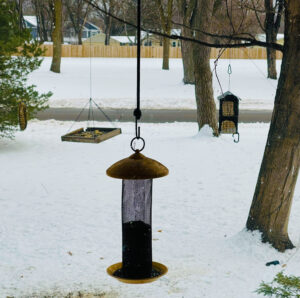
-
A variety of feeders for the birds.
-
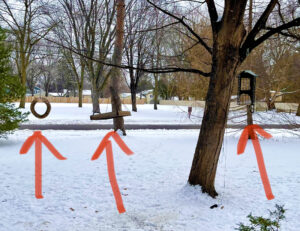
-
the “raiders” jump through hoops to get to the feeders.
When that happens, it’s time for an involuntary relocation.
This was the case on a frigid January morning here in Minneapolis. My live trap was set and within minutes I heard it snap shut. But what I then saw was a shock. The squirrel was trapped all right, but sitting next to the trap was an immature red-tailed hawk! She hopped onto the trap and all around it, trying to get at what she thought would be an easy breakfast.
Minutes later, she gave up and flew to a nearby perch to contemplate how she had been beaten by a 1-pound ball of gray fur.
I knew exactly how she felt.
-
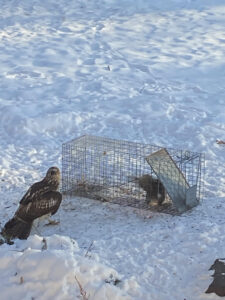
-
This immature red-tail hawk tries to figure out how to get the squirrel.
-
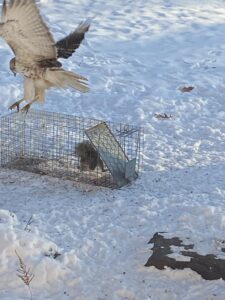
-
Landing on the trap
by Winding Pathways | Feb 3, 2022 | Birds, Garden/Yard, Nature, Uncategorized
Millions of families love watching chickadees, nuthatches and woodpeckers visit backyard feeders. A joyful daily task is bringing them a day’s supply of sunflower seeds, millet, or even cracked corn. But, often an important part of their diet is ignored.
Birds lack teeth so never need dental care. Instead, they must eat rocks! Small rocks humans call sand. Often birds forage along snowy roads gleaning grit spread to give cars traction. It goes into their gizzard where powerful muscles grind seeds into a digestible slurry that then moves on to the stomach.
During most of the year, birds find all the grit they need on their own, but when snow and ice seal off the soil they can’t find it. People sometimes scatter sand on slippery spots to provide human traction. Birds will glean some of it.
It’s helpful to sprinkle a handful of sand around feeders once a week during the snowy season. At Winding Pathways, we buy a 50-pound bag of chick grit at a local store that sells chicken feed. It’s fine ground hard rock that is ideal for both traction and bird digestion but plain old sand works.
Wild Turkeys often visit our feeders, so once in a while, we toss out large-sized grit, designed for laying hens. It helps their gizzards grind up hard corn kernels that they love snacking on.
An outstanding source of bird information is the Cornell University Laboratory of Ornithology.
-
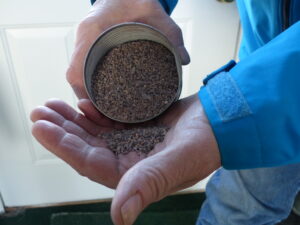
-
Chick grit is small.
-
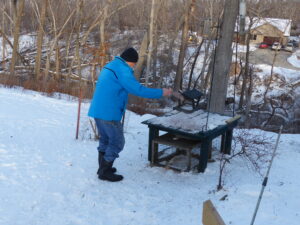
-
Sprinkle grit once a week to help birds in the snowy season.
-
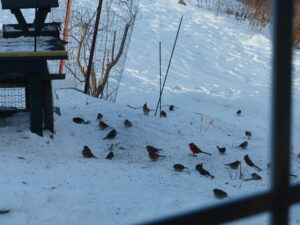
-
Birds flock to the seeds.
by Winding Pathways | Jan 6, 2022 | Birds, Nature, Pests
Artful Dodgers
Walking one of Cedar Rapids’ trails sometimes is like a skier racing a slalom course. Instead of weaving between flags, pedestrians must dodge piles of goose poop.
It wasn’t always that way. Before the mid-1980s few geese lived in town. Cedar Rapids began restoring them. About 125 of the giant birds were released near downtown. Few predators pester them and are they prolific! A goose couple can live for decades and raise upwards of a dozen goslings a year. That is a lot of geese!
Geese Mixed Blessing
Canada geese are a blessing. We love hearing “goose music” as they wing over our house. Watching such attentive parents teach their babies to swim and find food is great fun.
Canada geese are a curse, mostly because there are so many of them and they enjoy living, and pooping, in town. Their droppings are more than a walking nuisance. Loaded with nitrates and bacteria, they stimulate algae growth, lowering water quality.
-
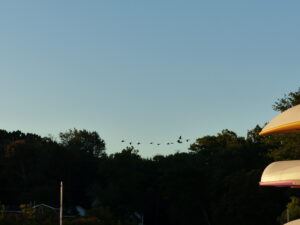
-
We enjoy the haunting call of geese on the wing.
-
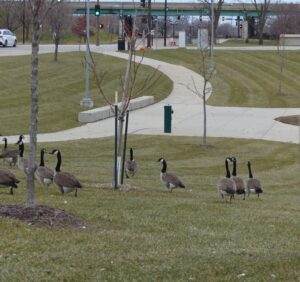
-
Geese love short grass
Geese Requirements
Geese love water but don’t need massive remote lakes. They prefer the dozens of small ponds at golf courses, corporate and school campuses, and parks. A lawnmower is a goose’s best friend. Well, maybe not a mower, but close-cropped lawns have tiny tender grass shoots that make fine goose dining. Running a mower down to a pond’s edge creates goose paradise. And problems for landowners.
People sometimes put snarling coyote mannequins near their pond to scare the big birds. It might work for a minute or two, but geese are smart. They figure out it’s a fake and nibble tender grass right under the phony predator.
How to Discourage Geese
Some cities reduce goose numbers by locating their nests, shaking the eggs to kill the embryos, which is called addling, or coating the eggs with oil so they won’t hatch. It may work to reduce flock size, but geese are protected by federal and state laws. Destroying eggs without a permit is illegal.
Legal Tricks
Here are less lethal and legal tricks that work, at least to some degree to discourage geese:
- Hold the chow. Folks love tossing stale bread to waterfowl, but it just encourages the crowding of the pesky birds.
- Stow the mower and let the grass grow. Geese shun tall grass. Even better, plant tall prairie grasses near the water’s edge.
- Fence ‘em out. For some reason geese don’t usually cross even small low barriers they could hop or fly over. A fence of lightweight plastic pipe set parallel to the edge of the water may discourage them from entering small areas.
We’ve got them. Geese are fellow city residents. We need to coexist, but a few simple tricks can discourage them from certain areas while still letting us enjoy delightful goose music as they wing overhead.
by Winding Pathways | Jan 5, 2022 | (Sub)Urban Homesteading, Flowers/Grasses, Garden/Yard, Garden/Yard, Nature
A raging blizzard roaring over Winding Pathways just before Christmas 2022 showed us the power of HARVESTING SNOW. We love catching it. Other parts of the country endure blizzards, especially Nor’ Easters
Well, we didn’t really catch the snow, but our prairie did. It has a talent for harvesting snow and other forms of moisture. It taught us how prairie and other taller plants – grasses, forbs, shrubs, vines, and trees – help themselves grow next summer.
Our prairie has a thick growth of two-foot-tall dead stems from last summer’s growth. Each stalk is brittle, but thousands of them working together slowed the wind just enough for it to drop the snow it had swept off nearby lawns and roads.
The deep drift that settled on our prairie will melt and give next spring’s plants a jumpstart in moist soil. Nearby shortly sheared lawns can’t catch snow and will start the spring on dryer soil. Nature delivered irrigation water to our yard for free!
Sharing Nature’s Wisdom
In dry regions of the country, snow also helps next summer’s vegetables. During college, Rich worked weekends at an Idaho ranch. He was surprised one January when Lucille Pratt, part owner of the land and an outstanding vegetable gardener, asked him to shovel a snow drift from nearby onto the garden.
For a Jersey boy, this seemed like a weird request. He did as asked and learned that melting snow oozed water into the soil. That helped get the vegetables going come spring and sustained them through the dry north Idaho summers.
Snow may be a bother to some, but it’s also a blessing to dry soil and the plants it sustains.
Over two blizzardy days, our prairie gently caught snowflake after snowflake. We already are looking forward to bright prairie flowers dancing in next summer’s breeze. Thanks, prairie for harvesting snow. Nature’s wisdom to catch winter’s snow and help next summer’s growth is amazing.
-
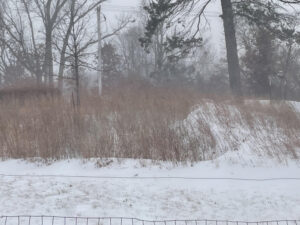
-
Capturing snow.
-
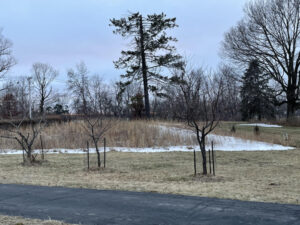
-
Three days later, a rapid melt left the ground bare, except where prairie plants held snow.
by Winding Pathways | Dec 9, 2021 | Garden/Yard, Nature
Meeting a Challenge
A few years ago, we received an email from the National Wildlife Federation asking us, and millions of others, to camp in the backyard once during the summer.
Upping the Ante
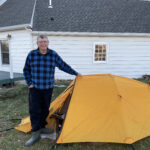
November makes 12.
We took it to heart and then went further. Over the past twelve months, Rich and occasionally Marion camped out at least once a month. The first time was on an unusually mild December night in 2020. The last one as November 2021 ended. In brilliant sunshine, Rich set up his backpack tent about 20 feet from the garage and spent a night punctuated by coyotes and owls vocalizing in nearby woods. The night completed his camping every month for the past year.
Some months – like in the dark of winter – Rich tented in the back yard. After an evening of reading or watching a Great Courses DVD Rich bid “Good night” and stepped into the cool evenings, snuggled into the thick sleeping bag – preheated with “Hot Hands” packs, and enjoyed the evening serenades.
Watching the Weather
January and February 2021, Rich camped back to back. The predictions were mild for January 31st and February 1st. And, cold was on its way. So, Rich pushed away snow and set up his tent next to the barn where the chickens sleep. He was aroused at 4:00 a.m. when the light we use to wake the birds did just that. Between the bright light shining in his tent and the rooster’s crowing Rich gave up and came in about 4:30 a.m. Still, the overnight counts!
Combining Interests
In warmer months when fishing beckoned, he would head to NE or SE Iowa and come back with a string of trout or panfish.
The few times we traveled further afield, we tented – March in Kansas with the campground to ourselves; September and October in the East under beautiful stars and in the pouring rain.
Why Backyard Camp?
Backyard camping is great fun, even in a tiny urban yard. It also has these advantages over trekking to a distant state or national park:
- Spontaneous decision. No need to take time off work or school. Just set up the tent behind the house, add a sleeping pad and bag, and camp.
- Choosing the weather. If it’s cold, hot, windy, rainy, or (gasp) snowy, wait for a more pleasant night.
- No camping fee or need to drive anywhere.
- Easy to drag in many blankets and pillows that might not be taken on a camping trip somewhere.
- During winter’s long dark nights just stay inside to watch tv or read before sleeping in the tent.
- It’s an adventure….at least for kids.
-
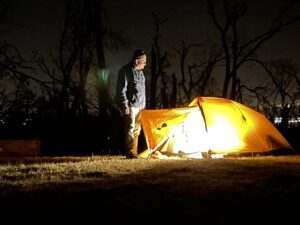
-
First of 12 tentings.
-
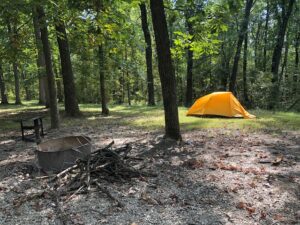
-
Summer camping is easy.
-
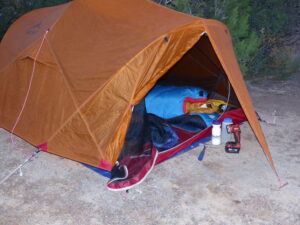
-
Sometimes we use cots for more comfort.
-
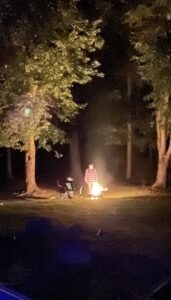
-
A Campfire adds a cozy feel.
With 12 months down, will Rich’s streak of every month camping continue????? We’re not sure, but likely it will.
















